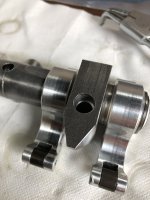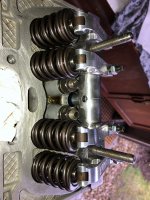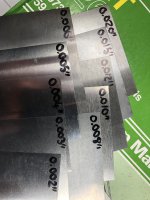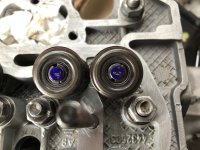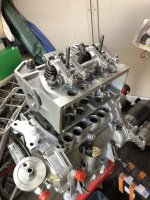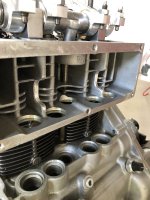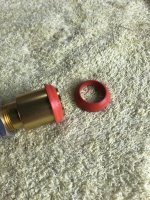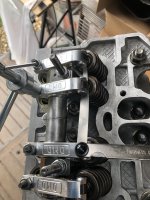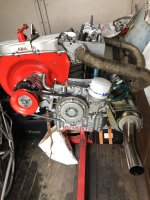Greetings All, Apologies to those who don't know, this thread has nothing to do with Skin Heads and Teddy Boy's.
A brief update regarding my two engines as I'm dancing the engine Hokey - Cokey a swap from the Hot to the Not so hot engine!!! This is the first time I have had the chance to get them together complete and ready to run.

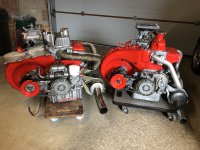 The one on the left is the fully balanced job with a 40/80-80/40 cam and a c/r of 10.5:1 with Solex twin choke. The one on the right is the 'not-so-hot job' with 35/75-75/35 cam and a c/r of 9.8:1 using a weber 30 DGF (32bhp at the wheels@5000rpm) it also has a complete 'Bambino' fan housing, but that said I never want to rebuild one of these again - Nightmare !!!
The one on the left is the fully balanced job with a 40/80-80/40 cam and a c/r of 10.5:1 with Solex twin choke. The one on the right is the 'not-so-hot job' with 35/75-75/35 cam and a c/r of 9.8:1 using a weber 30 DGF (32bhp at the wheels@5000rpm) it also has a complete 'Bambino' fan housing, but that said I never want to rebuild one of these again - Nightmare !!!
The principle reason for removing the 'Hot' engine is to carry out a few upgrades and Mod's, the head will have 35mm inlet valves fitted and I have treated myself (Christmas + B

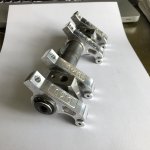



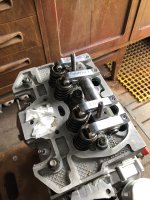 irthday) to a neat Rocker Roller set from DMD. Having made some lengthy research into the basic valve function I have found that roller rockers can release wasted output by keeping the valve stem from excessive contact with the internal wall of the valve guide. Even though there is oil involved it does not fully remove the friction caused by the action of the rocker arm on the valve top. Essentially the vale rocks from side to side against the guide, roller rockers ensure that the valve moves straight up and down and with a bearing on the rocker shaft there is little movement friction of the rocker on a plain shaft. The rockers themselves are constructed from 'Ergal' Alloy which is a 7075 Alloy used in aircraft parts having good ductility, resistance to fatigue and high strength - tough all round. The rollers should minimise tappet noise too. I had the rocker rail apart recently and have found a very high construction level with all parts well made. The final pic shows the rail on the head, but this is only for illustration as the rockers and steel mounts all need to be accurately shimmed for spacing and height, I may have to have another set of pushrods cut to suit this application anyway!
irthday) to a neat Rocker Roller set from DMD. Having made some lengthy research into the basic valve function I have found that roller rockers can release wasted output by keeping the valve stem from excessive contact with the internal wall of the valve guide. Even though there is oil involved it does not fully remove the friction caused by the action of the rocker arm on the valve top. Essentially the vale rocks from side to side against the guide, roller rockers ensure that the valve moves straight up and down and with a bearing on the rocker shaft there is little movement friction of the rocker on a plain shaft. The rockers themselves are constructed from 'Ergal' Alloy which is a 7075 Alloy used in aircraft parts having good ductility, resistance to fatigue and high strength - tough all round. The rollers should minimise tappet noise too. I had the rocker rail apart recently and have found a very high construction level with all parts well made. The final pic shows the rail on the head, but this is only for illustration as the rockers and steel mounts all need to be accurately shimmed for spacing and height, I may have to have another set of pushrods cut to suit this application anyway!

A brief update regarding my two engines as I'm dancing the engine Hokey - Cokey a swap from the Hot to the Not so hot engine!!! This is the first time I have had the chance to get them together complete and ready to run.
 The one on the left is the fully balanced job with a 40/80-80/40 cam and a c/r of 10.5:1 with Solex twin choke. The one on the right is the 'not-so-hot job' with 35/75-75/35 cam and a c/r of 9.8:1 using a weber 30 DGF (32bhp at the wheels@5000rpm) it also has a complete 'Bambino' fan housing, but that said I never want to rebuild one of these again - Nightmare !!!
The one on the left is the fully balanced job with a 40/80-80/40 cam and a c/r of 10.5:1 with Solex twin choke. The one on the right is the 'not-so-hot job' with 35/75-75/35 cam and a c/r of 9.8:1 using a weber 30 DGF (32bhp at the wheels@5000rpm) it also has a complete 'Bambino' fan housing, but that said I never want to rebuild one of these again - Nightmare !!!The principle reason for removing the 'Hot' engine is to carry out a few upgrades and Mod's, the head will have 35mm inlet valves fitted and I have treated myself (Christmas + B


 irthday) to a neat Rocker Roller set from DMD. Having made some lengthy research into the basic valve function I have found that roller rockers can release wasted output by keeping the valve stem from excessive contact with the internal wall of the valve guide. Even though there is oil involved it does not fully remove the friction caused by the action of the rocker arm on the valve top. Essentially the vale rocks from side to side against the guide, roller rockers ensure that the valve moves straight up and down and with a bearing on the rocker shaft there is little movement friction of the rocker on a plain shaft. The rockers themselves are constructed from 'Ergal' Alloy which is a 7075 Alloy used in aircraft parts having good ductility, resistance to fatigue and high strength - tough all round. The rollers should minimise tappet noise too. I had the rocker rail apart recently and have found a very high construction level with all parts well made. The final pic shows the rail on the head, but this is only for illustration as the rockers and steel mounts all need to be accurately shimmed for spacing and height, I may have to have another set of pushrods cut to suit this application anyway!
irthday) to a neat Rocker Roller set from DMD. Having made some lengthy research into the basic valve function I have found that roller rockers can release wasted output by keeping the valve stem from excessive contact with the internal wall of the valve guide. Even though there is oil involved it does not fully remove the friction caused by the action of the rocker arm on the valve top. Essentially the vale rocks from side to side against the guide, roller rockers ensure that the valve moves straight up and down and with a bearing on the rocker shaft there is little movement friction of the rocker on a plain shaft. The rockers themselves are constructed from 'Ergal' Alloy which is a 7075 Alloy used in aircraft parts having good ductility, resistance to fatigue and high strength - tough all round. The rollers should minimise tappet noise too. I had the rocker rail apart recently and have found a very high construction level with all parts well made. The final pic shows the rail on the head, but this is only for illustration as the rockers and steel mounts all need to be accurately shimmed for spacing and height, I may have to have another set of pushrods cut to suit this application anyway!



